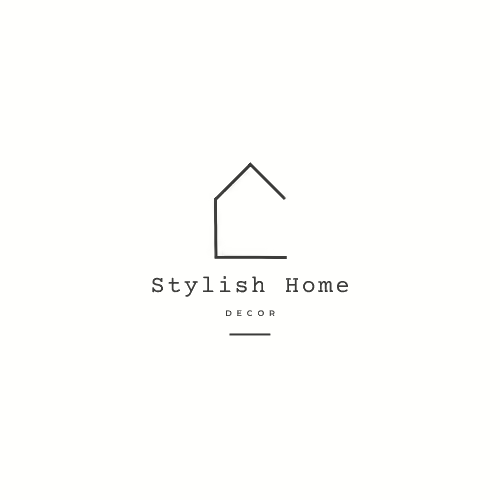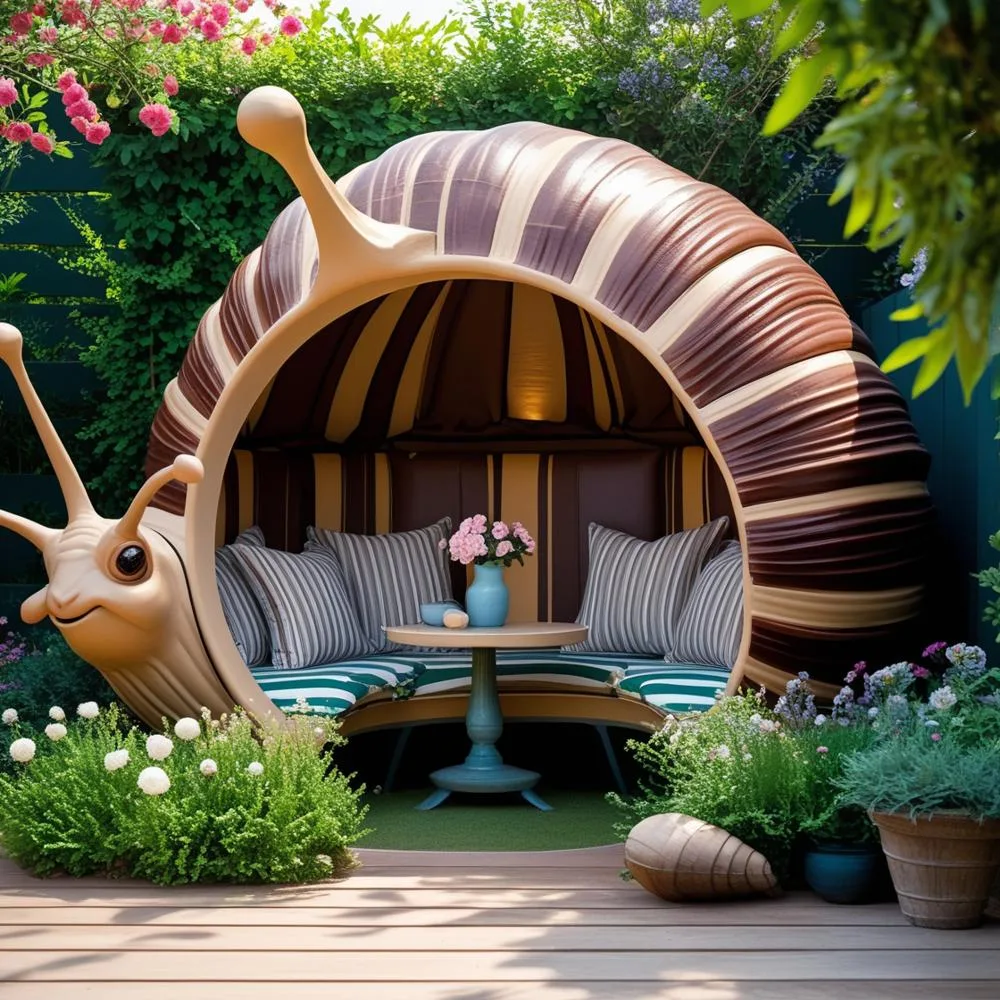Picture this: you step into your backyard and are greeted by a stunning insect-shaped outdoor seating area—a dragonfly-inspired pergola, a ladybug-shaped lounge, or a butterfly bench that seems to flutter in the breeze. These imaginative designs are more than just places to sit; they’re artistic expressions that blend functionality with nature’s beauty. An insect-shaped outdoor seating area brings a whimsical, eco-conscious vibe to your garden, creating a space that’s as inviting as it is unique. In this comprehensive guide, we’ll dive deep into designing, constructing, and maintaining an insect-shaped outdoor seating area, offering inspiration and practical tips to make your garden the envy of the neighborhood.
Why an Insect-Shaped Outdoor Seating Area is a Game-Changer
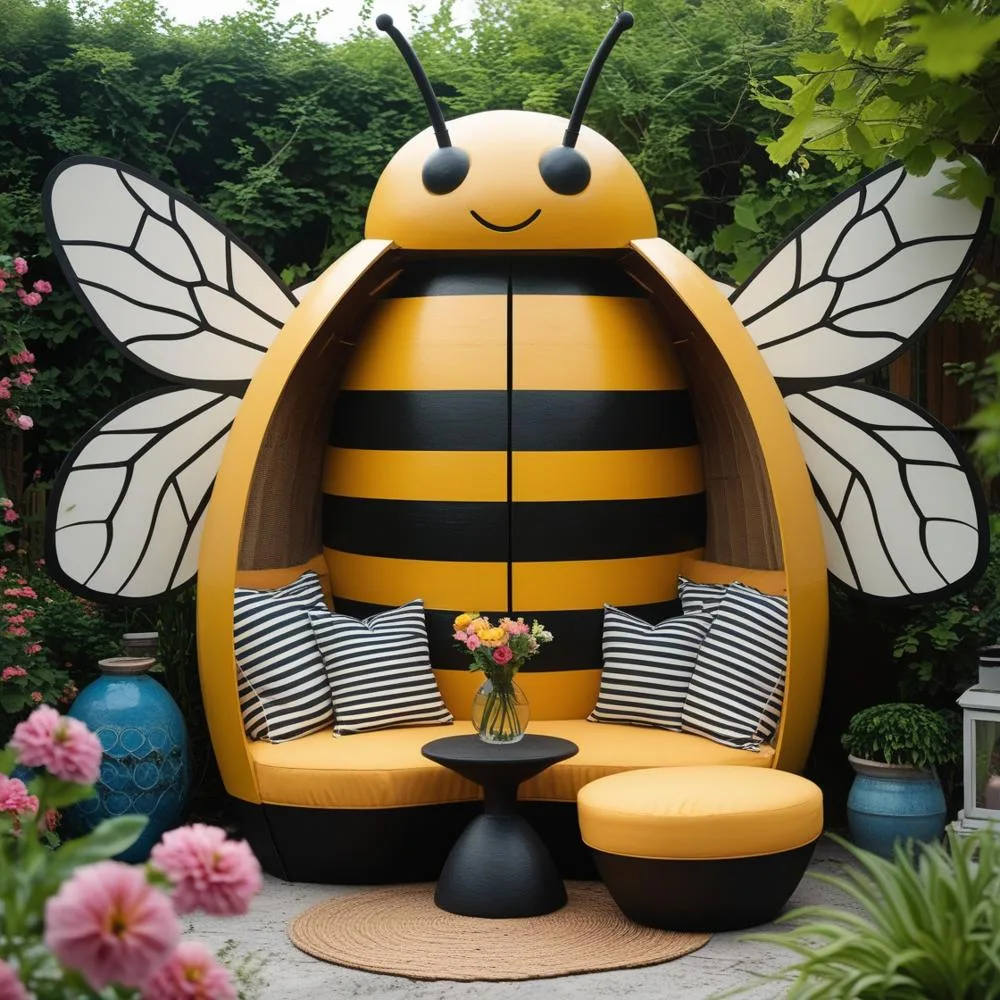
A Fusion of Artistry and Practicality
An insect-shaped outdoor seating area is a perfect marriage of form and function. Whether it’s a beetle-shaped bench with sleek curves or a grasshopper-inspired sectional, these designs provide comfortable seating while doubling as eye-catching garden sculptures. They’re ideal for homeowners who want their outdoor space to reflect creativity and personality.
Celebrating Nature and Sustainability
Insects are vital to our ecosystems, and an insect-shaped outdoor seating area celebrates their role in nature. By using sustainable materials like reclaimed wood, bamboo, or recycled metal, you can create a seating area that’s as eco-friendly as it is beautiful. Pair it with pollinator-friendly plants like lavender or bee balm, and you’ll attract real butterflies, bees, and other beneficial insects, supporting biodiversity in your backyard.
Universal Appeal for All Ages
From children who adore the playful, storybook-like designs to adults who appreciate the craftsmanship, an insect-shaped outdoor seating area captivates everyone. It’s a versatile addition to family gardens, community parks, or even commercial spaces like cafes or boutique hotels looking to create a memorable outdoor experience.
Boosting Your Property’s Value
A well-executed insect-shaped outdoor seating area can enhance your home’s curb appeal and market value. Unique, nature-inspired features stand out to potential buyers, especially those who value sustainable and creative outdoor spaces.
Designing Your Dream Insect-Shaped Outdoor Seating Area
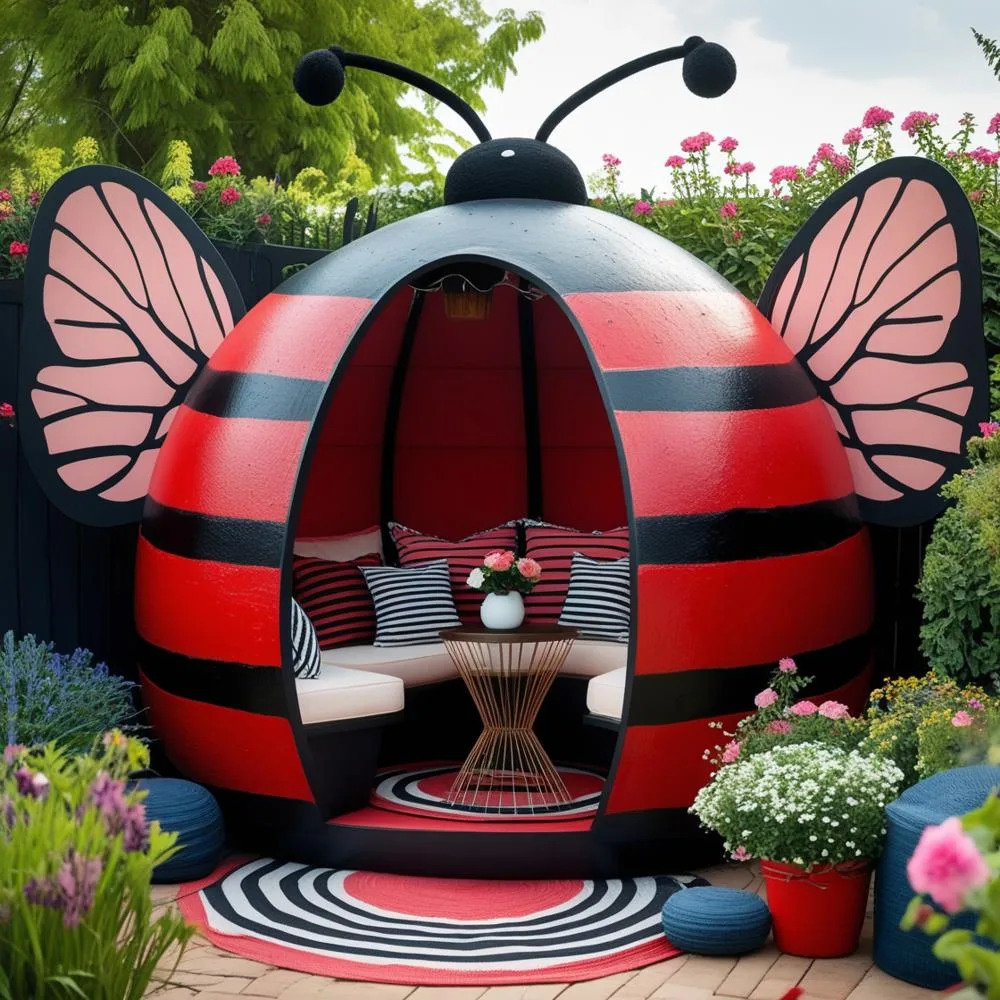
Step 1: Pick Your Insect Muse
The heart of your project lies in choosing an insect to inspire your seating area. Here are some popular options, each with its own aesthetic charm:
- Butterfly: Graceful wing-shaped benches or pergolas with vibrant, mosaic-like patterns.
- Ladybug: Cozy, round seating with bold red and black polka-dot cushions.
- Dragonfly: Sleek, elongated designs mimicking delicate, iridescent wings.
- Beetle: Sturdy, glossy benches with curved, armor-like structures.
- Ant: Modular, interconnected seating that mimics an ant colony’s structure.
Consider your garden’s size, style, and the mood you want to evoke. A compact urban patio might call for a single ladybug chair, while a sprawling backyard could host a butterfly-themed conversation pit.
Step 2: Map Out the Layout
Before you start building, plan your insect-shaped outdoor seating area with precision. Key considerations include:
- Space Allocation: Measure your garden to ensure the seating area complements the space without overcrowding it. A small bench might need only 4×4 feet, while a pergola could require 10×10 feet or more.
- Accessibility: Design clear pathways to and from the seating area, using stepping stones or gravel for a natural look.
- Sun and Shade Balance: Position the seating area to take advantage of natural shade from trees or add a canopy for sun protection.
- Focal Point: Make the seating area a centerpiece by surrounding it with plants or a water feature.
Step 3: Choose Sustainable Materials
The materials you select will determine the durability, aesthetic, and environmental impact of your insect-shaped outdoor seating area. Popular options include:
- Wood: Cedar, teak, or eucalyptus for natural beauty and weather resistance.
- Metal: Powder-coated steel or aluminum for a modern, low-maintenance finish.
- Recycled Materials: Upcycled plastic, reclaimed wood, or repurposed pallets for an eco-conscious design.
- Fabrics: Weather-resistant cushions in insect-inspired colors like emerald green, ruby red, or metallic blues.
- Natural Elements: Incorporate stone, wicker, or bamboo for a rustic, organic feel.
Step 4: Incorporate Functional Features
Think beyond seating to make your insect-shaped outdoor seating area a multi-purpose space:
- Storage: Build benches with hidden compartments for cushions or gardening tools.
- Tables: Add a small, insect-themed side table for drinks or decor.
- Shade Structures: Include a pergola or canopy shaped like insect wings for sun protection.
Building Your Insect-Shaped Outdoor Seating Area
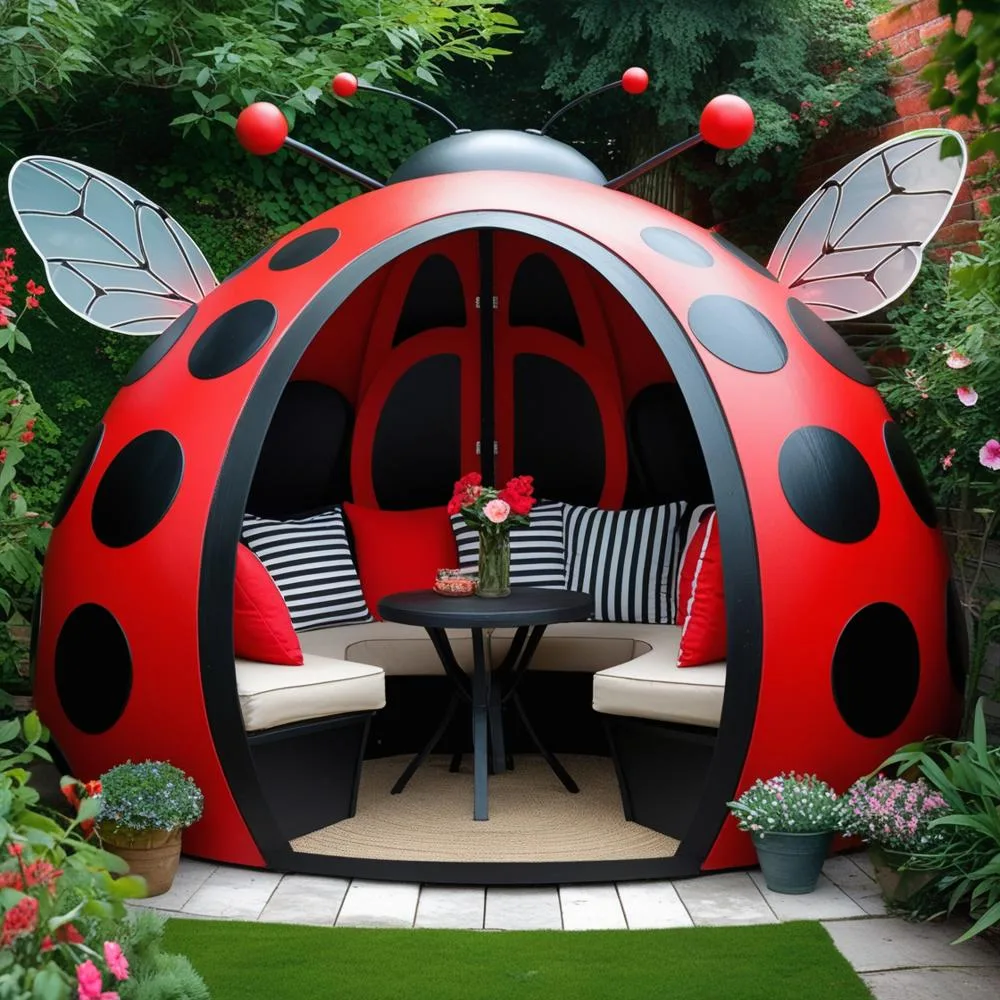
DIY vs. Hiring Professionals
If you’re a DIY enthusiast, a simple insect-shaped outdoor seating area, like a ladybug bench, is achievable with basic tools and materials. However, intricate designs, such as a dragonfly pergola with curved metalwork, may require professional expertise to ensure safety and longevity. Weigh your skills, budget, and timeline before deciding.
Essential Tools and Supplies
For a DIY project, you’ll need:
- Measuring tape, level, and pencil for precise planning.
- Circular saw, jigsaw, or hand saw for cutting materials.
- Drill, screws, and outdoor adhesive for assembly.
- Sandpaper or a sander for smooth finishes.
- Weather-resistant paint, stain, or sealant in insect-inspired hues.
- Upholstery foam and outdoor fabric for cushions.
Step-by-Step Construction Guide
- Design the Frame: Create a sturdy base shaped like your chosen insect. For a butterfly bench, cut wood or metal into wing-like forms for the backrest and seat.
- Add Signature Details: Carve or paint insect-specific features, like ladybug spots or dragonfly wing veins, to bring the design to life.
- Assemble the Seating: Attach wooden slats, cushions, or metal panels for comfortable seating. Ensure all joints are secure.
- Apply Protective Finishes: Use a weatherproof sealant or paint to protect against rain, UV rays, and pests.
- Install in the Garden: Place the seating area in its designated spot, leveling the ground if needed. Secure larger structures with anchors or concrete footings.
Safety Tips
- Wear protective gear like gloves and goggles when cutting or drilling.
- Ensure the seating area is stable and can support weight without tipping.
- Use non-toxic paints and sealants to keep the area safe for kids, pets, and wildlife.
Elevating Your Insect-Shaped Outdoor Seating Area
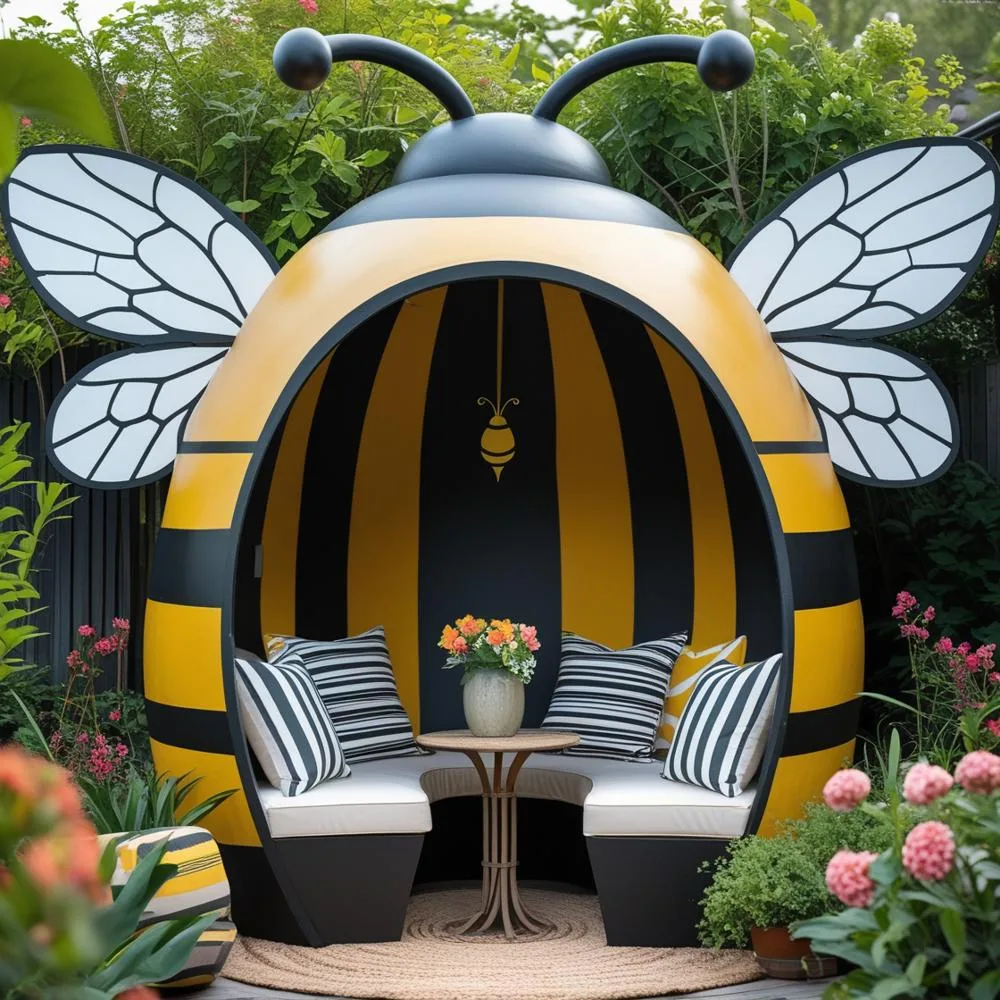
Lighting for Ambiance
Extend the usability of your insect-shaped outdoor seating area into the evening with strategic lighting:
- Solar-Powered Lights: Line pathways or hang lanterns for eco-friendly illumination.
- String Lights: Drape over a pergola or wrap around a bench for a fairy-tale glow.
- LED Spotlights: Highlight the insect design to make it a nighttime focal point.
- Glow-in-the-Dark Accents: Use phosphorescent paint on details like wing patterns for a magical effect.
Landscaping and Plant Integration
Surround your seating area with plants to enhance its natural charm:
- Pollinator-Friendly Plants: Attract bees and butterflies with nectar-rich flowers like coneflowers, salvia, or milkweed.
- Ground Covers: Use clover, thyme, or moss for a soft, insect-friendly base.
- Vertical Elements: Add trellises or arbors with climbing roses or clematis for privacy and height.
- Edible Plants: Incorporate herbs like mint or basil for a functional, aromatic touch.
Insect-Themed Accessories
Complete the look with decor that ties into the insect theme:
- Throw Pillows: Patterns featuring wings, spots, or nature motifs.
- Outdoor Rugs: Durable rugs with subtle insect or leaf designs.
- Sculptures: Small metal or ceramic insect figures as accents.
- Water Features: A birdbath or fountain shaped like a leaf to attract birds and insects.
Maintaining Your Insect-Shaped Outdoor Seating Area
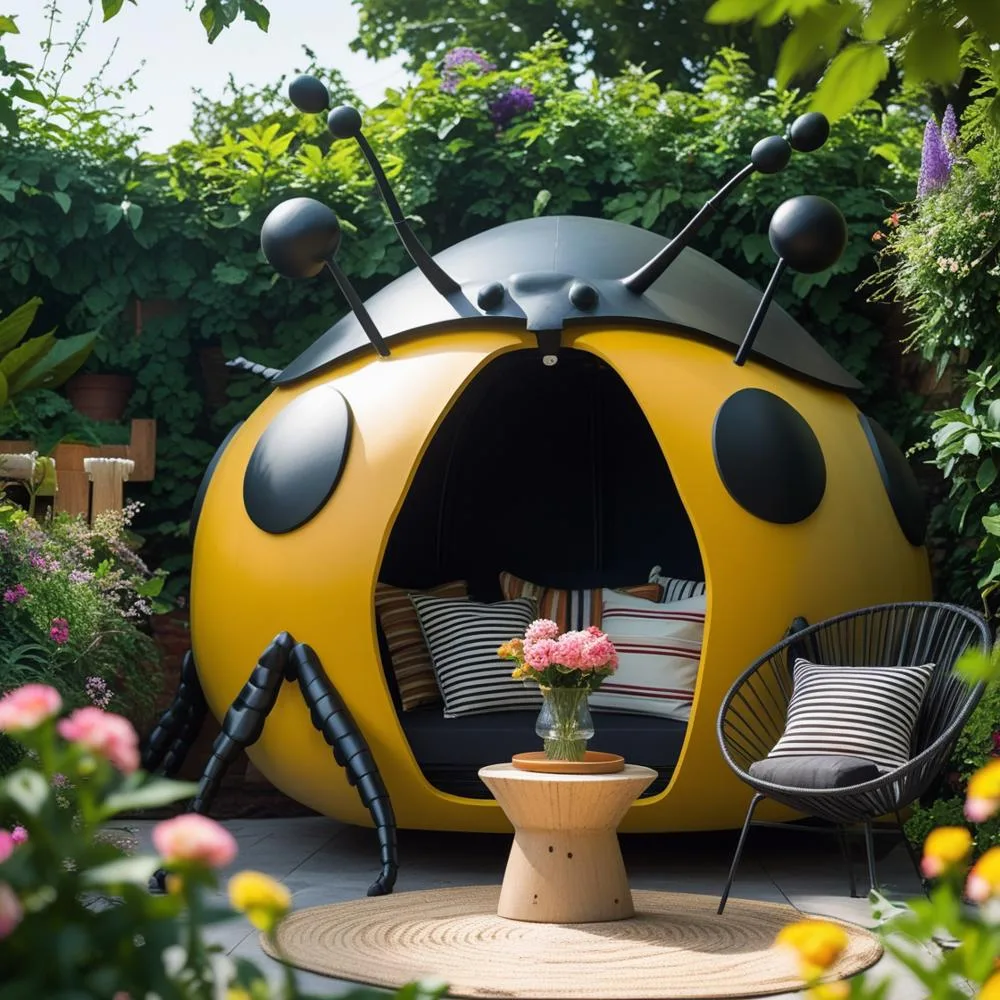
Routine Cleaning
Keep your seating area pristine with regular care:
- Wipe surfaces with a mild soap-and-water solution to remove dirt, pollen, or bird droppings.
- Clean cushions with a fabric-safe cleaner and store them indoors during storms or winter.
- Check for wear, such as peeling paint or rust, and address it promptly to prevent damage.
Seasonal Maintenance
- Spring: Inspect for winter damage, refresh paint or sealant, and prune nearby plants.
- Summer: Monitor for mildew on cushions and ensure plants are watered during heatwaves.
- Fall: Clear leaves and debris to prevent staining or rot.
- Winter: Cover the seating area with a tarp or move portable pieces to a garage to protect from snow and ice.
Eco-Friendly Maintenance Practices
Use natural, non-toxic cleaning products to avoid harming plants or wildlife. For example:
- A vinegar-water mix cleans wood or metal without chemicals.
- Baking soda scrubs stains from cushions without polluting runoff.
- Compost fallen leaves or plant clippings to enrich your garden soil.
The Many Benefits of an Insect-Shaped Outdoor Seating Area
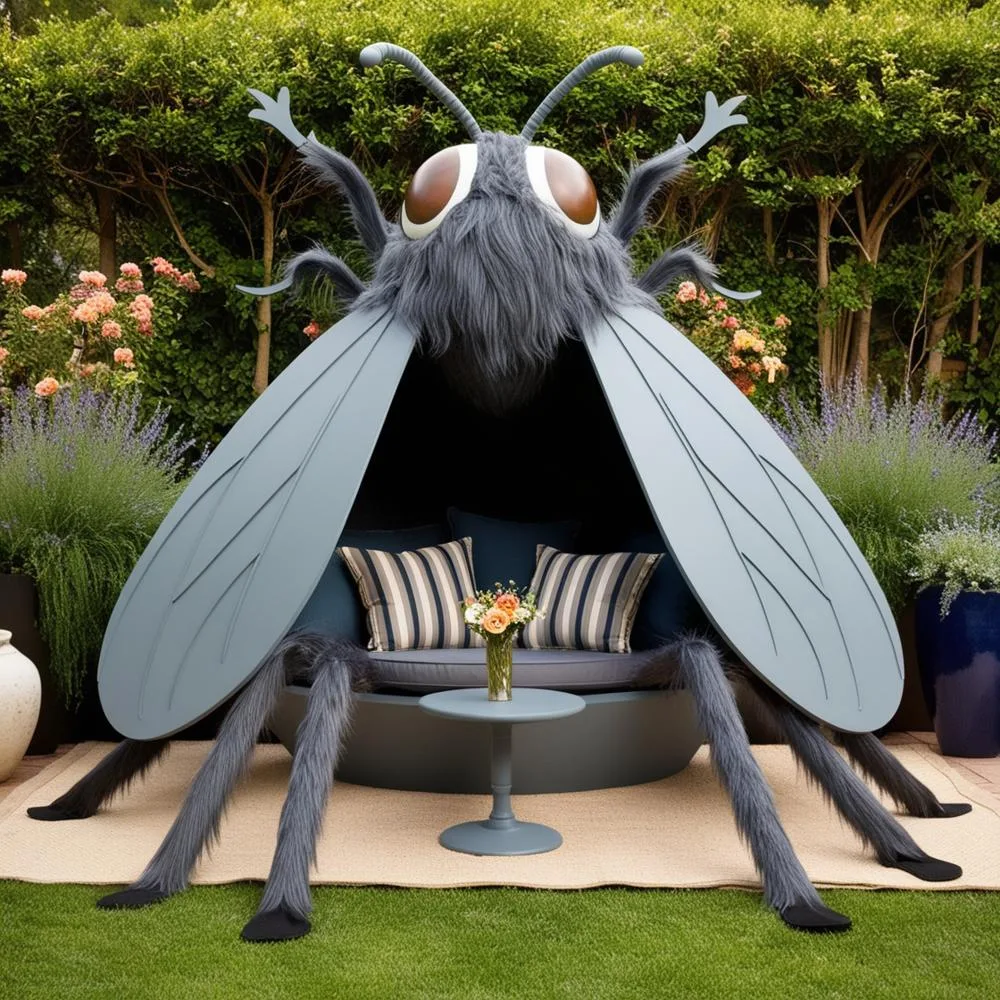
Enhances Outdoor Living
This unique seating area encourages you to spend more time outside, whether hosting summer barbecues, reading in the shade, or stargazing with loved ones. It creates a dedicated space for relaxation and connection.
Increases Property Appeal
A thoughtfully designed insect-shaped outdoor seating area can make your home stand out in the real estate market. Buyers are drawn to creative, eco-friendly features that add character and value.
Promotes Environmental Stewardship
By using sustainable materials and fostering a pollinator-friendly environment, your seating area contributes to a healthier planet. It’s a small but meaningful step toward supporting local ecosystems.
Sparks Joy and Creativity
The playful, imaginative design of an insect-shaped outdoor seating area brings joy to everyday life. It’s a reminder to embrace creativity and find beauty in the natural world.
Real-Life Inspiration for Insect-Shaped Outdoor Seating Areas

The Butterfly Haven
A botanical garden in Florida features a butterfly-shaped pergola with wing-like slats painted in pastel hues. Surrounded by a meadow of wildflowers, it’s a popular spot for weddings and educational tours.
The Beetle Retreat
A family in Colorado crafted a beetle-shaped bench from reclaimed barn wood, finished with a glossy green stain. It’s the centerpiece of their backyard, where they gather for storytelling and s’mores.
The Dragonfly Oasis
A boutique winery in California installed a dragonfly-inspired patio with metal benches resembling wings. Paired with a bubbling fountain, it’s a serene spot for wine tastings and sunset views.
The Ant Colony Lounge
A community park in the UK created an ant-themed seating area with interconnected wooden benches mimicking an ant hill. Kids love climbing and playing on it, while adults relax nearby.
FAQs About Insect-Shaped Outdoor Seating Areas
How Much Does It Cost to Build?
Costs depend on materials, size, and whether you DIY or hire professionals. A simple DIY ladybug bench might cost $100–$400, while a custom dragonfly pergola could range from $1,500–$7,000 with professional installation.
Are These Seating Areas Weather-Resistant?
Yes, when constructed with durable materials like teak, cedar, or powder-coated metal and sealed properly, they can withstand years of rain, sun, and snow with regular maintenance.
Can I Make It Portable?
Smaller designs, like a ladybug chair, can be made lightweight and movable. Larger structures, like pergolas, are typically fixed but can be designed with modular components for easier relocation.
How Do I Ensure It’s Eco-Friendly?
Use sustainable materials, non-toxic finishes, and pollinator-friendly plants. Avoid synthetic chemicals and opt for solar-powered lighting to minimize environmental impact.
Bring Your Garden to Life with an Insect-Shaped Outdoor Seating Area
An insect-shaped outdoor seating area is more than a garden feature—it’s a celebration of nature, creativity, and sustainable living. Whether you’re dreaming of a butterfly pergola that dances in the sunlight or a cozy ladybug lounge for family gatherings, this unique addition will transform your outdoor space into a haven of beauty and functionality. By carefully designing, building, and maintaining your seating area, you’ll create a lasting masterpiece that inspires joy, supports local ecosystems, and elevates your home’s charm.
So, what are you waiting for? Grab a sketchpad, choose your favorite insect, and start planning your insect-shaped outdoor seating area today. Your garden is ready to buzz with personality and purpose!
